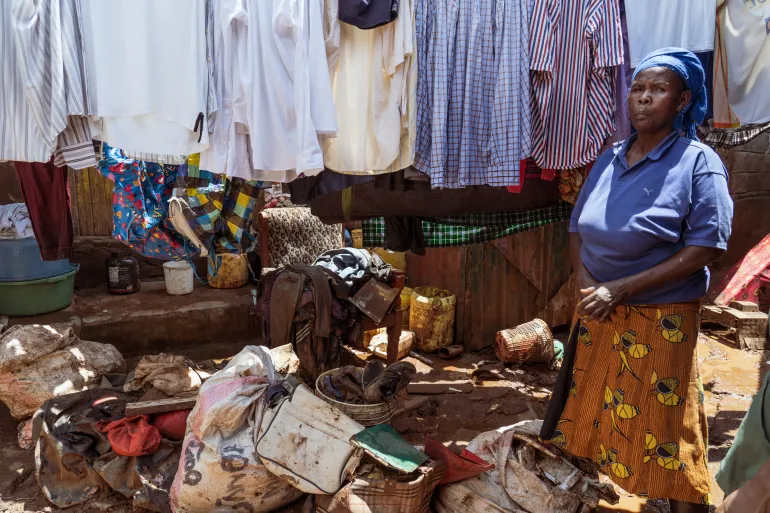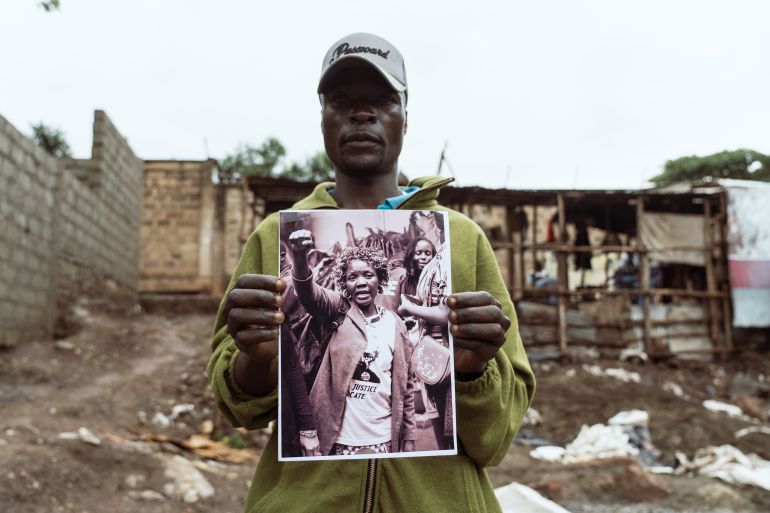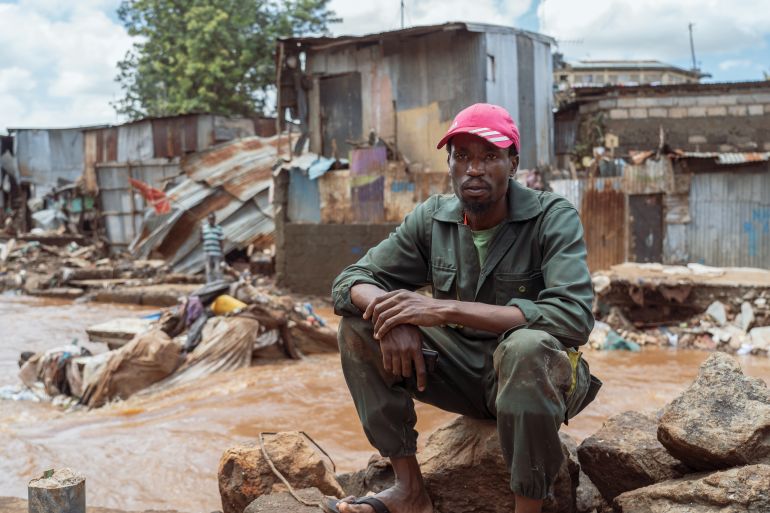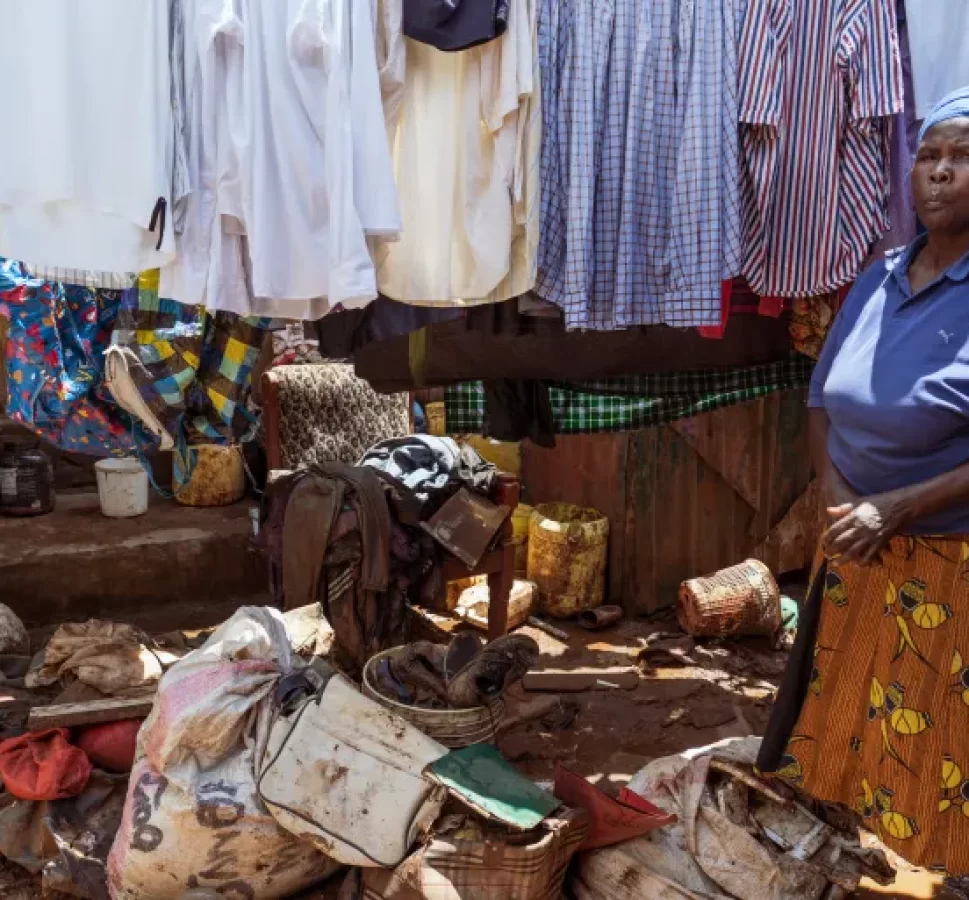
In Mathare, one of the largest informal settlements in Nairobi, residents grapple with flood damage, loss and lack of state assistance.
Nairobi, Kenya – Collins Obondo stood atop the rubble of a house in Mathare, one of the largest informal settlements in Kenya’s capital Nairobi, surveying the aftermath of a flood that destroyed his neighbourhood.
“This is all that’s left of my mother,” the 38-year-old said, looking down at the heap of muddy miscellaneous items gathered together on top of where her house once stood.
Last Tuesday, residents awoke in the middle of the night to the frantic shouts of “Maji! Maji!” (Water! Water!) after torrential rain triggered widespread flooding across the capital. The overpopulated settlement is situated within a valley through which the Mathare River flows. The waters had begun rising sharply, reaching about 35 metres (115 feet) high, sweeping away hundreds of makeshift homes built along the riverbed and submerging thousands more.
Obondo’s mother, Benna Buluma, who was a community activist known locally as “Mama Victor”, drowned in the floods. Obondo survived because he happened to be somewhere else, but his home, located beside hers, was also destroyed.
“It’s been hard to make sense of all of this,” Obondo said, adding that everyone who was home at the time died, including Buluma’s two small grandchildren who were with her at the time.
The children’s fathers – Victor and Bernard – were killed by Kenyan police in 2017. In the years since, Buluma had devoted her life to demanding justice for them, along with many families who have lost loved ones to police bullets.
“My mother spent years fighting for justice for the neglected people of the slums. And it was that same government neglect she was fighting against that killed her,” Obondo said, his voice rising.
“I blame all this on the government,” he said about the loss and destruction that residents say they have been left alone to grapple with in the aftermath of the flood.

Kenya’s government announced the deployment of the military, national police, coastguard, and the national youth service to enhance its emergency response efforts across the country. Yet traumatised residents in Mathare, including Obondo, said no one from the government has come to assist them.
“The government says they deployed the military and the national youth service and they are stepping up search and rescue missions, but where are they? It has been a week and where are they? I have not seen anyone here in Mathare. Not one person from the government has come to help us,” Obondo said.
“If anyone claims my mother died because of climate change, just know they are lying. It was the government that killed her. They are the ones responsible for this.”
‘I lost my child’
In Mathare, like other informal settlements in the capital, daily life has been shaped by historic government neglect, with its almost 69,000 residents lacking adequate access to clean drinking water, electricity, proper drainage or sewage systems.
As the rising waters quickly crept towards homes last week – most of which are made from tin sheets – residents attempted to flee but could not see in the darkness. Many, including children, who were living near the riverbed were swept up into the waters and drowned before reaching the safety of higher ground.
The day after the flood, Obondo began the search for his missing relatives, finding his mother’s body and some of his relatives and neighbours. However, the bodies of Buluma’s small grandchildren have still not been found.
According to the Mathare Social Justice Centre (MSJC), a community-based human rights organisation, more than 40 bodies have so far been retrieved from the river. But there are at least dozens of residents still missing.
About 800 families in Mathare, comprising thousands of people, have become homeless after their houses were completely destroyed, while at least 2,000 homes are now uninhabitable.

Mathare’s narrow alleyways are still littered with debris. Water drips from draped clothes hanging on ropes tied between shacks. Wet mattresses and broken furniture are piled atop puddles and mud. Displaced residents sift through the rubble in an attempt to salvage any of their belongings that remain.
Without government assistance, those with missing relatives are also resorting to digging through the wreckage with makeshift tools and hammers to find the bodies of their loved ones.
Days after the flood, Al Jazeera saw one distraught man shovelling through mud and debris with a broken bottle. “I am trying to find my child,” he said. “I lost my child.”
Among the worst affected parts of Mathare is the 4a area, known colloquially as “Mradi,” where residents have settled alongside the river. People’s homes and businesses were entirely destroyed by the flood.
Resident Joseph Runo, 32, sat on top of the wreckage, tiredly staring at what remained of his once lucrative pig-rearing business. Shortly before the flood, he had invested all his savings into extending his business into constructing a hot-water shower for Mathare’s residents to use in exchange for a small fee. Parts of the large water tanks he bought now float in the river behind him.
“We never thought a tragedy like this would happen,” said Runo, burying his face in his palms. “This has left all of us in a very bad state. I didn’t have any other business. I have a family to care for and now I have to start from scratch. We have to rebuild our entire lives.”
El Nino
Across the country, lives have been devastated by floods and flash floods over recent weeks. Since March, Kenya has been battered by above-average rainfall, exacerbated by climate change and the effects of the El Nino weather pattern, which is typically associated with increased heat worldwide and leads to drought in some parts of the world and heavy rains in others.
According to the government, at least 169 people throughout the country have so far been killed in floods and landslides caused by the heavy rains, while more than 185,000 have been displaced. Nairobi has been among the worst affected, with tens of thousands of families made homeless.
While El Nino often has devastating consequences in the East Africa region – last year, more than 300 people died in rains and floods in Kenya, Somalia, and Ethiopia – residents in Mathare say this time was different.
“I’ve lived in Mathare since 1983 and I have never witnessed the river rise to that level before,” said 52-year-old Alice Ndiege, whose home was submerged in the flooding. “El Nino is the most feared rain. The floods take over the roads but they never reach here. I’ve never seen anything like this.”

The 2023-2024 El Nino has peaked as one of the five strongest on record, according to the United Nations.
Thousands who lost their homes in Mathare were forced to sleep on the streets on higher ground, huddling around fires. Many are still seeking shelter at schools and churches. Ndiege has returned to her now-destroyed home to retrieve some of her possessions.
“Now we have nothing … not even a single blanket,” she lamented, gesturing to a pile of muddy and ruined clothes and purses. “It would take me years to get back what I’ve lost. I don’t know where I can even start.”
Bernard Oketch, 36, lives about one kilometre (0.62 miles) from the Mathare River. Yet the waters still reached his house and submerged it. He fled his home with his wife and children – ages nine and two months – when the waters had already reached his waist. Oketch’s home is among the few in Mathare built from concrete so the structure survived the flooding; however, he lost most of his possessions.
“My child will have to return to school soon and all of his books, documents, and school uniform were destroyed in the flooding,” Oketch told Al Jazeera, sitting on a damp mattress at his home, beside his sleeping child. “The people here really need assistance, but the government is neglecting us.”
“Imagine if you had thousands of people becoming homeless overnight in Kilimani or Kileleshwa [upscale areas of Nairobi], the government would respond immediately,” Okoth said. “But because we are poor people in the slums, they have left us all here to die.”
‘We need the government’
The M4 area of Mathare was submerged by flooding once again on Sunday night, as heavy rains continued to pummel Nairobi. Various possessions residents retrieved from the flooded area and which were piled on the streets have now all been swept away.
Rumours have spread around Mathare that the unprecedented flooding was worsened by a dam collapsing upstream, which became overwhelmed by the rainfall.
“The water levels of the river rise sometimes due to the rains, but never to this extent,” explained Mary Njeri Mwangi, an activist from MSJC. “But the government has not confirmed anything and we haven’t heard any explanation of what actually transpired.”
On Monday, a dam in western Kenya collapsed, killing more than 40 people. The government has warned that five dams located in the lower Tana region in the eastern part of Kenya were at total capacity and urged residents to move to higher ground and expect massive downstream overflows.
With forecasts of even heavier rainfall in the coming days, the despair of deserted residents in Mathare is transforming into anger.

According to Mwangi, displaced residents are being assisted with food and clothes mostly by concerned citizens and community-based organisations like MSJC.
“But it’s still not enough,” the activist said.
“People are hungry and they need clean water. Some people have small children and infants. Women are pregnant and sleeping on the streets. No one is attending to us here. Community solidarity can only do so much. It’s a desperate situation and we need the government to help.”
Al Jazeera reached out to Isaac Mwaura, Kenya’s government spokesperson, for comment, but did not receive a response.
Many residents in Mathare believe the extensive damage from the flooding cannot just be blamed on extreme weather events caused by climate change. Historic government neglect of Nairobi’s slum residents, who make up the overwhelming majority of the city’s population, is the primary culprit, they say.
“It’s been 60 years since we got independence [from the British],” Mwangi explained. “And we still have the majority of this city living in abject poverty, without basic services and without decent housing. Our youths are killed by constant fires that erupt from people trying to tap into electricity lines, drug overdoses, crime-related violence, and police brutality. Now, the waters are also killing them.”
“If the government had allocated funds to assist people in the slums to live with dignity, free from constant state brutality, then these floods would not have impacted people in this way.”






